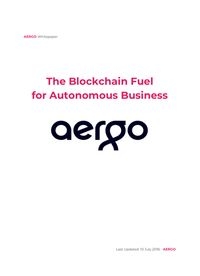
EXECUTIVE SUMMARY
When Satoshi Nakamoto introduced Bitcoin to the world in 2008, the new cryptocurrency was
meant to enable electronic cash payments directly between individuals without the use of
banks. Ten years later, the groundbreaking technology Nakamoto invented to power Bitcoin
is being championed by enterprises in all kinds of industries as a way to radically improve
their future products, services and businesses.
As the digital world moves towards a next generation utility computing model (where value is
created across open networks and highly distributed ecosystems), blockchain has the
potential to become one of the primary enterprise platforms to build these systems and
ecosystems on.
In this new world, attention is likely to move away from developers having to understand and
cater for complex IT architectures and the respective management and operation functions.
This can help allow them to focus on application innovation and value creation at the front
end of the process, where applications touch and interact with the end-user (and billions of
future IoT devices). In this “serverless architecture” much of the IT complexity will be
abstracted or simply hidden from the developer and the end-user. Applications will run as
containers and microservices on a combination of secure private and public clouds, delivered
from a wide variety of managed cloud delivery partners.
In order to achieve the promise to become one of the major platforms for this kind of utility
computing world, a step change is required. Not only around core elements of the blockchain
operating system itself, but in creating a completely new “enterprise blockchain platform” and
associated ecosystem. These need to support the creation, deployment and management of
new secure distributed microservice-based applications on blockchain.
To become mainstream (so that companies and third-parties can create value in this new
world) the technologies, tools and methods need to be robust while being simple to use. They
also need to be low cost.
This paper introduces AERGO: a next generation enterprise blockchain protocol and
platform. AERGO aims to become one of the core mainstream IT architectures and models
used by application developers and enterprise companies across a vast number of industries.
It is envisioned that thousands of innovative new products, services and business
ecosystems will emerge that are built and run on AERGO.
In order to explain the current and future target market (i.e. describe the existing problem and
business opportunity that lies ahead) this paper summarises a number of important enterprise
needs, and fast evolving IT, technology and blockchain trends. Whilst many technical
concepts are described, many of these have been simplified to explain them in a
business-friendly manner. We also include more detailed information on each core topic by
way of the included appendices (for example a blockchain “primer” in Appendix-A).
Core elements of AERGO are built on technologies developed by Blocko. Blocko is a leading
blockchain firm that has helped some of the world's leading firms to design and deploy real
business systems on a secure blockchain. Over the past four years it has learned a lot.
Blocko believes that its existing core technology and advanced blockchain in-production
capabilities could form the basis of a new advanced blockchain platform for business. Proven
technologies, that are already in use with over 25 million users.
Blocko is contributing its core technology to AERGO. It may also deliver future services to the
AERGO including consulting and maintenance services to future customers of AERGO.
As the open source platform develops and achieves higher levels of adoption with developers
and businesses, it is anticipated that other companies may offer similar and complementary
services to Blocko for AERGO.




